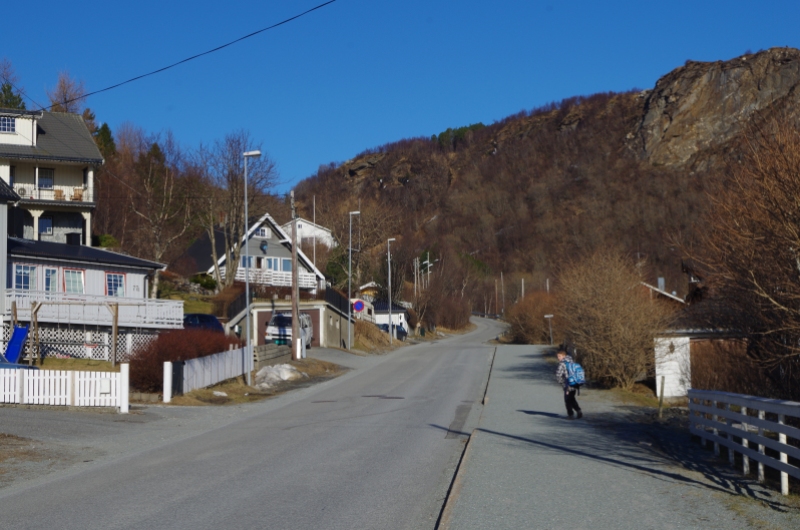
Yesterday, I descended through bright blue skies to land in Bodø, Norway, a city of about 50,000 people that’s a little over 100 miles north of the Arctic Circle. I’m here to participate in High North Dialogue, a conference which will be taking place this week at the University of Nordland. Bodø, located on Norway’s dramatic coastline, has a port that is called upon daily by the Hurtigruten, the country’s famed coastal steamer. That means there are lots of tourists wandering around quayside including myself, although I came in by plane. The airport is only about a fifteen minute walk from the center of town. Close by, too, are the National Joint Headquarters, which have operational command of Norway’s armed forces. They are located in Reitan, a town just outside Bodø.
To the top

Walking a few kilometers past the train station (which I will write more about later this week after traveling on the Nordland Railway), I headed up the road into the hills north of town. This being March, it’s not the prettiest time of year. Most of the snow has melted, exposing squishy brown dirt that hasn’t yet been reclaimed by carpets of bright green grass. But it was a strikingly sunny and clear day, so once I reached the top of the road, I was able to see for miles across the blue Norwegian Sea. The distinctive shape of the rugged, mountainous coastline is striking. It resembles the California coast turned upside-down: whereas out west, flat-topped cliffs drop off precariously into the crashing whitecaps of the Pacific Ocean, these snow-capped Norwegian mountains of granite stumble upward out of a flat ocean into the wind-whipped air.

As I walked, I noticed small children playing without adult supervision. This is always a remarkable sight to someone from an American city. They huffed and puffed their way up the road in order to ride their scooters gleefully down the hill. Other kids, seven years old at most, walked home by themselves. Golden retrievers and Bernese mountain dogs (who did, in fact, have adult supervision) frolicked in the melting snow. Some of the lakes still appeared frozen, though water was gushing out of them downstream.

After taking in the views, I headed back down into town, where the evening commute had begun. People cycled home on their bicycles, shopped at the Co-op Mega grocery store, and hopped off buses. I saw blond kids with thick-rimmed glasses, teenage girls in Chelsea boots, and women in hijab. Bodø is a diverse place, for many immigrants to Norway settle in its northern communities. As Norwegian news website News in English noted in 2012, “around 17,000 refugees have settled in Norway in the past three years, record numbers of them outside the capital that’s traditionally been a magnet for more immigrants.” In 2013, Hammerfest won the Norwegian Directorate of Integration and Diversity’s integration prize. In certain northern locales, immigration has helped to reverse what otherwise would have been a depopulation trend as native-born Norwegians move south to the big cities of Oslo and Bergen.
The integration of immigrants into these Arctic communities is a welcome story in the face of increasing military tensions between Norway and Russia. After ten days out of the spotlight, Russian President Vladimir Putin has reappeared into public view, back to his daily tasks of shaking hands with Central Asian leaders and ordering military exercises in the Arctic. A Russian Ministry of Defense press release notes that Sergey Shoigu, who holds the formidable titles of being both Russia’s Minister of Defense and the country’s largest collector of ancient samurai swords, remarked,
“Supreme Commander of the Armed Forces of the Russian Federation Vladimir Putin has decided to test the combat readiness of the Northern Fleet and assess their capacity of the central regions of Russia with the tasks in difficult climatic conditions.”
Shoygu added, “New challenges and military threats require further increase the capacity of the armed forces.” It seems that new threats are always being conjured in the Arctic, often by militaries themselves. Alexei Arbatov, a Scholar-in-Residence at the Carnegie Endowment for International Peace, explained to Gazeta, a Russian newspaper, “We scare ourselves that we have someone from the Arctic (who will) attack.” (The article is worth reading in full in the original Russian text or through Google Translate). Arbatov astutely noted that resource wars are no longer a threat in the Arctic, if they ever were. He remarked, “The sharp fall in oil prices and in the technological development of shale gas and shale oil reserves of interest in the Arctic shelf has pushed into the background the resource component of potential conflict in the Arctic.” All the same, he thinks that the level of preparedness of the military in northwest Russia should be improved since falling into disrepair during the 1990s.
And so all of the units of Russia’s Northern Fleet – including some 38,000 soldiers, 3,360 pieces of military equipment, 41 warships, 15 submarines, and 110 aircraft and helicopters – have been called upon to test their readiness. The week before, on the other side of the Russian-Norwegian border, Norway began its largest winter exercise in Finnmark since 1967 with 5,000 soldiers and 400 vehicles. This number, however, is less than the 6,000 immigrants who have summited Norway’s highest mountain, Galdhøpiggen, over the past few years as part of the state-led integration program Til Topps (“To the top”). The annual event encourages new arrivals to experience Norwegian nature, develop a sense of friluftsliv (“open air living”), and make new friends. Let’s hope that there are more projects in the north that promote communication, from Til Topps to High North Dialogue, rather than militarization and disintegration.
